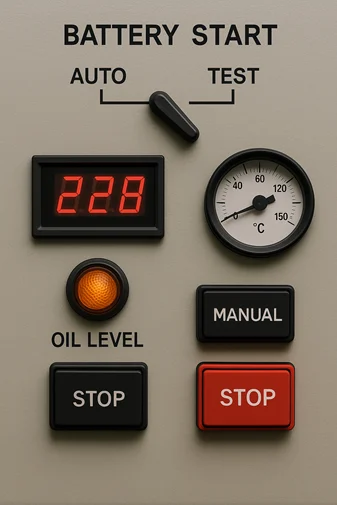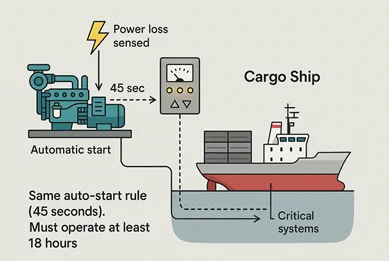What Is an Emergency Generator?
An emergency generator is a backup power system installed on every ship. When the main generators fail due to blackout, machinery fault, or casualty, this generator kicks in automatically to provide power to critical systems.
It’s placed in a separate space away from the engine room, usually higher up, so that it remains safe even if the lower decks are flooded or damaged.
3 Ways to Start the Emergency Generator
1. Automatic Start (Most Common)
- In the event of a blackout, the emergency generator senses the loss of power.
- It starts automatically and takes over the load within 45 seconds (as per SOLAS rules).
- This is the primary starting method, fast and hands-free.
Example: During bad weather or while transiting a narrow channel, if the ship suddenly blacks out, the emergency generator will come on and restore critical lighting, steering gear power, and communications without needing crew intervention.
2. Manual Start (From the Control Panel)
Sometimes, the automatic system might fail. That’s why you must know how to start the generator manually.
Steps:
- Go to the emergency generator room.
- On the panel, select “Engine” mode. This starts the engine only.
- Select “ACB” (Air Circuit Breaker) mode. This starts the engine and connects the load.
- The generator starts using a battery-powered motor, which cranks the engine and brings it online.
3. Mechanical Spring Starter (Backup of the Backup!)
If electrical systems fail completely, there’s still one more way to start it – the mechanical spring starter.
Steps:
- Engage the spring starter to the engine.
- Put the fuel lever to the maximum position.
- Charge the spring manually using a handle. (You’ll see the indicator turn from green to red, which means it’s fully wound.)
- Remove the handle.
- Push the starter lever down, and the generator starts!
This method doesn’t need any electricity, only your muscle power and some grit!
Weekly & Monthly Checks: Keeping It Reliable
Even the most advanced equipment is useless if it’s not tested. That’s why ships have a maintenance routine:
- Weekly: Run the generator on battery mode without load.
- Monthly:
o Start it on hydraulic mode (if fitted).
o Test the automatic start by simulating a power failure.
o Keep it running for 10–15 minutes and check oil levels, exhaust temperature, and volt/frequency output.
Understanding SOLAS Requirements
SOLAS (Safety of Life at Sea) mandates certain rules for emergency power systems.
Passenger Ships
- Generator must start & take load within 45 seconds.
- Must run for at least 36 hours.
- Power should cover:
Emergency lighting, alarms, radios, navigation lights, steering gear, and at least one fire/bilge pump.
Cargo Ships
- Same auto-start rule (45 seconds).
- Must operate at least 18 hours.
Batteries:
- Must provide 30 minutes of power to lights, alarms, radios, and internal communication if generator fails.

Quick Recap: Start-Up Procedures
Battery Start
- Switch from “Auto” to “Test” mode. Generator starts without load.
- Check voltage, temperature, oil level.
- To stop: go to “Manual” → Press Stop.
Hydraulic Start
- Check pressure gauge.
- Open valve from accumulator to generator.
- Push spring valve and the generator starts.
After stopping, recharge accumulator and close valve.
Automatic Start
- Simulate blackout by opening the breaker between MSB & ESB.
- Generator starts and takes load automatically.
- Close the breaker to stop it (due to interlock, it drops load).
Set mode to “Manual” → Stop.


